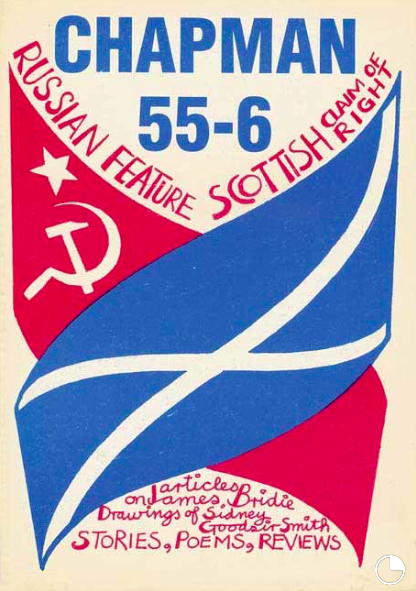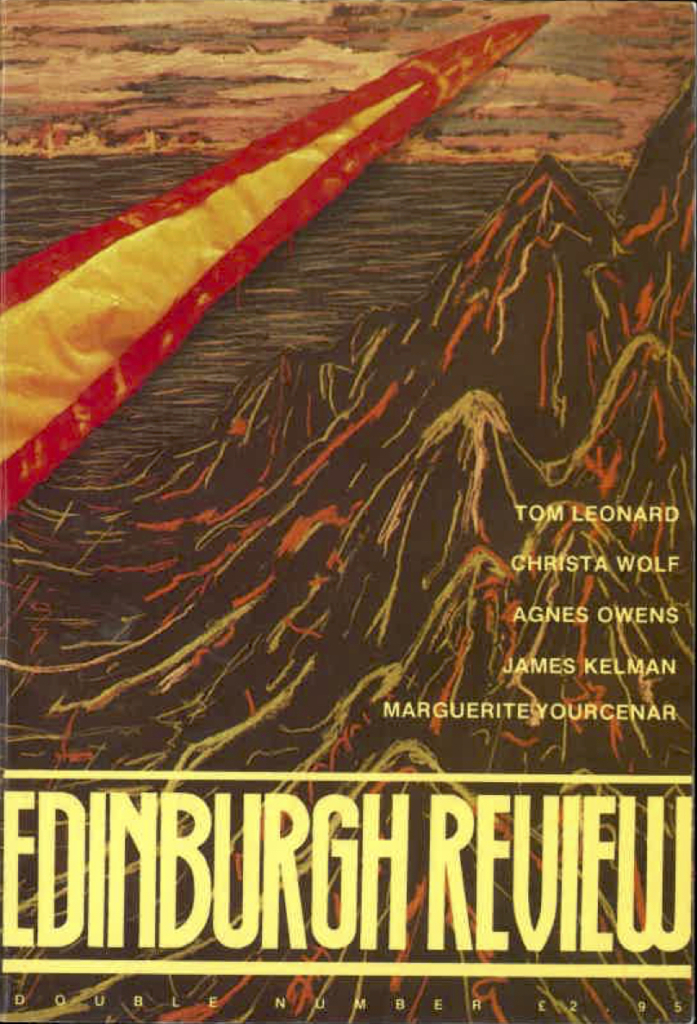Scottish Magazine Culture and Influence 1968 – 2000


If you recognise any of these magazine covers, we’d love to hear from you!
Sparked by Scottish International in 1968, a range of small independent magazines played a major creative role in Scottish literature, culture and politics over the next three decades.
It’s easy to see Bella Caledonia (including its print incarnations) continuing in this tradition. These magazines were focused on cultural and political commentary, and also published poetry and short fiction. They were the key venue in which writers, journalist, activists and critics developed a common discourse about Scottish cultural difference, literary revival and democratic dissent.
Writing in Radical Scotland in 1983, George Kerevan noted that ‘politics is no longer confined to the Establishment and Labourist agenda of economic tinkering. Cultural values represent a new Second Front’. The arena of this ‘second front’ was established – and gradually expanded – by titles such as New Edinburgh Review (from 1969), Chapman (1970), Crann-Tàra (1977), MsPrint (1978) and Cencrastus (1979). By the 1980s, these magazines had significant influence on the ‘first’ front – the field of electoral politics – in yoking together assertions of Scottish cultural identity and demands for constitutional change. Looking back, we can see post-1960s magazine culture as the laboratory in which the ‘new’ Scotland of devolution was experimentally debated and formed.


The Scottish Magazines Network is a research project focused on these titles and the light they cast on modern Scotland, and we’d love to hear from anyone with memories or reflections about this small magazine scene. Were you a subscriber, reader or contributor? Did you play a role in producing, distributing or selling these magazines? No matter the nature of your involvement or curiosity, you’re invited to an online public event on Wednesday 12 May at 8pm.


We’ll be speaking with Peter Kravitz, the legendary editor of Edinburgh Review (relaunched in 1984), and the director of the student-run Polygon Press in the period when launched the careers of James Kelman, Janice Galloway and Agnes Owens (among others). We’ll also be hearing from Glenda Norquay, Professor of Scottish Literary Studies at Liverpool John Moores University, who was a member of the Cencrastus editorial team in the early 1980s.


Anyone interested in Scotland’s cultural, political and publishing history will find this a stimulating event. To reserve your place, just email [email protected]. The event will run from 8pm on Weds 12 May, and will be over by 10pm at the latest.
For more on the world of the magazines, do check out the many blogs and podcasts already up on the project website, with more coming soon. We hope to make a further podcast based on the memories and stories of people we connect with at this event, so please do get involved. You can get all the project updates via Twitter or Facebook.

I contributed to some of these titles, though not to the particular issues illustrated here. That culture of ‘small magazines’ now seems weirdly exotic, even to someone who was now and then involved: a disturbing thought … When I started to work abroad I became a contributor to the Grenoble-based Etudes écossaises, as encouraged by the expat scholar Keith Dixon and other colleagues. But I continued to write for Cencrastus, Chapman, Lines Review and a new (1995) kid on the block, the Scottish Review. The Edinburgh University based Scottish Affairs followed; its books editor was the late and much-missed Eberhard (‘Paddy’) Bort.
Thanks Tom
Tom – great to see the mention of Keith Dixon. Are you still in touch with him. many years back he invited me and Jim Smyth to talk about Radical Scotland at a symposium he organised in Lyon. Was an amazing discussion with his knowledgable students. There are probably more French people, students of his, who have a great knowledge of Scottish politics, than over largely thanks to Keith. Best wishes Douglas
It’s interesting that this, and a previous initiative published on BC a few years ago, fail to mention what was probably the longest-running, but certainly one of the less publicity-conscious – because strictly functional – magazines of this period.
The Scottish Trades Union Review was produced quarterly from about 1977 to maybe 2000, by the Trades Union Research Unit at what started life as Glasgow College of Technology, and is now the Caley (GCU). I mention it here because I’ll not be able to participate in the event you mention. I may (I hope) still have a fair run of copies in boxes in my son’s loft, but I’m sure the excellent Scottish Trades Union Archive in the Library of GCU has a full set.
Thank you for alerting us.
As a historical footnote (in case it has slipped from memory), most of these magazines were fairly thoroughly indexed from 1976 onwards in the Bibliography of Scotland that was published by the National Library of Scotland. From 1976 to 1987 this appeared in the form of annual printed volumes that should still be available in research libraries. From 1988 onwards it appeared in various digital formats which were eventually cumulated into a project called Scottish Bibliographies Online. Ironically, this is now available only as a dataset in the Digital Foundry section of the NLS website and can only be used if you have access to some fairly specialised software.
I’m not sure what it it tells us about the line of progress that this kind of information has survived better on paper than in electronic format.
The poetry magazines are indexed in the Scottish Poetry Library’s online catalogue. I’d obtained funding for the work from the Scottish Libraries Information Council (SLIC) during 1992 and the work was undertaken after I left to work in France at the beginning of 1993. Thank you Dennis for drawing attention to the alarming fact that so many valuable online research tools have been left to languish. This needs to be rectified.
Information on some of the magazines can be found on GoodReads.
Hi Dennis. Graham Watt here. I hope you are well ! My email address is [email protected]
My wife and I are just back from a week in the NE, staying with friends at Durris, and the discussion arose about the origins of the quality homes in Stonehaven. Where did the money come from in the late 1890’s to build the high percentage of standalone villas, as they were called , and who were the people who signed the contracts? I’m thinking of Bath St , for example, and Baird Terrace, where quite magnificent homes were built all the way to Maxiburn. I have an interesting book by Jane Geddes but she is interested in the architecture. Is there a history of the people, the personalities, or there a project for someone?
There are even strands of continuity with the ‘Reforesting Scotland’ journal, founded over 30 years ago as ‘The Tree Planter’s Guide to the Galaxy’, and still going strong under the editorship of Mandy Meikle. The journal has championed land reform, rewilding, action on climate change, rewilding, hutting and environmental arts. Andy Wightman was an early ‘guest editor’. Kevin Dunion has contributed to ‘Reforesting Scotland’. Alastair McIntosh enjoys the rare distinction of having written for ‘Cencrastus’, ‘Radical Scotland’ AND ‘Reforesting Scotland’!
“Alastair McIntosh enjoys the rare distinction of having written for ‘Cencrastus’, ‘Radical Scotland’ AND ‘Reforesting Scotland’!”
… and Bella Caledonia
Just so! I was thinking deadwood magazines! 🙂
More seriously, the ‘Reforesting Scotland’ journal is of significance in the development of Green politics in Scotland.
There was also Scottish Book Collector, which ran from 1987 to 2004, and of which I’m sure I still have copies boxed up somewhere in my shed. Its archive also seems to have provided the starting point for the Textualities website, http://textualities.net/about
Hi Tom, Dougie, Dennis, Graeme — many thanks for these comments. Please do come along to the event if you can, as we’d love to pursue these points further — making these magazines available to researchers is one of our long-term aims, working in partnership with NLS.
Even if you can’t make it on 12 May, we’re hoping to record folk’s reflections for a podcast episode, so please email [email protected] to get involved!
Bella might want to consider commissioning an article in Gaelic on ‘Gairm’ and an article in Scots on ‘Lallans’ magazine to complement this excellent initiative.
Be good to see Harpies and Quines represented; i was on editorial collective for a short while around 91/92 but Lesley Riddoch was the driving force and editor. Thinks the Guardian’s Libby Brooks volunteered too whilst still at school!
Hi Susan
H&Q gets a mention here along with a number of other feminist magazines including NESSIE: A Radical and Revolutionary Feminist Newsletter in Scotland:
https://campuspress.stir.ac.uk/scotmagsnet/2021/03/17/modern-scottish-magazines-a-long-view/
Scotia Review Founded By David Morrison in 1970 as Scotia and then Scotia Review in 1972 For the Scottish muse and nation .
https://www.scottishpoetrylibrary.org.uk/poet/david-morrison/
The magazines depicted here inhabited a mainstream: their production and content values were such that Menzies would be comfortable to distribute; a writer would feel comfortable to list their published articles on a CV. Their archives are amenable to genealogical research to validate influential outcomes.
Charlotte Lauder’s “long view” piece linked above does begin to touch on broader circles over the years, and the important interplay between consumption and production in publications.
There existed in parallel other ‘zines which were inkier, far more pungent, strident. These could emerge briefly from the early-60s anti-bomb movement, from political groups or music subcultures. What were their drives, to what extent did they form or feed off the communities of their moment?
As an example take “Skelf”. I haven’t seen a copy this past 50 years; if I did, it would probably appal me as offensive, quaint, of its time. Even to ask the questions of their motivation, their drive, their dissolution is extremely difficult – for a start, are any of their writers even identifiable? But these seem no less important than the Menzies-distributed mags.